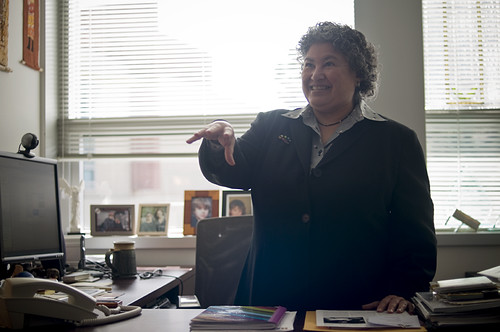
By Vikram Singh/Special to Xpress
It’s a three letter acronym that carries a negative connotation. Reactions to the pronouncement of this word range from fear and shock to total apathy. It’s HIV.
Cynthia A. Gomez, director of the Health Equity Institute at SF State, has been in the fight against these reactions since the beginning of the AIDS epidemic 30 years ago.
“It was hard not to know someone affected by the disease,” Gomez said. “I was in Boston at the time running a mental health clinic.”
Now armed with money from AIDS United, she has been finding and linking into HIV care for the 8,000 people in the Bay Area who know they are HIV positive but are not receiving life-saving care and treatment. She is using the $2 million grant to support community outreach programs in San Francisco and Oakland.
“The more communities that we can shrink the availability of that virus and the potential for that exposure, the more we are able to strangle the virus,” she said.
SF State’s Health Equity Institute created the Bay Area Network for Positive Health last year to help coordinate their efforts. BANPH consists of 11 agencies around San Francisco and Oakland dedicated to lowering the number of people who are HIV positive and without care. With the HEI acting as its hub and mentor, BANPH “reaches out in a holistic and empowering way,” according to Gomez, to those most at risk of being infected or to those already with the disease.
Danielle Gordon, HEI evaluation and clinical coordinator, understands that those marginalized by society face the biggest obstacles to receiving treatment, and works with clinics to address the causes of health inequities for these people. She said that people who have been previously incarcerated, for example, are less likely to receive care.
Gordon acknowledges that the program has seen success in the past year and a half.
“Over 200 people have come through the program, and at least 100 have been linked up with care,” she said. “It took a long time to get going. A lot of groundwork was needed to create credibility within the community.” To achieve this, BANPH invited clinics around the Bay Area to take part in the program.
Nicholas Moss, San Francisco Department of Public Health’s new director of Clinical Prevention unit of HIV prevention, is aware of the barriers to care that people face. The unit is affiliated with BANPH and provides follow-up coverage to patients in and out of the justice system.
“Consider us the last line of defense,” Moss said. “We can’t compel people to take the medicine, but what can we do is remove all the barriers to the medicine.”
In 1981 the stigma of AIDS was so great that people were afraid of getting treatment. Then the public mobilized and the blame shifted from one group to another before it was realized the problem was biological, not cultural. Gomez remembers when the call to action was strong and people were aware of the problem. Nearly three decades later, fear has been replaced with apathy.
“We have become so dependent on the notion that we can live without promoting our own health,” Gomez said.




